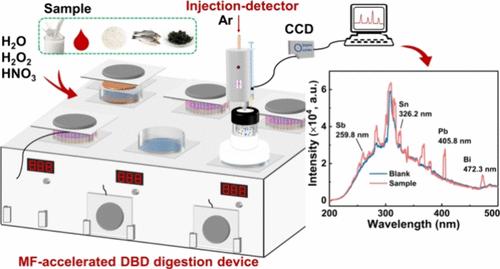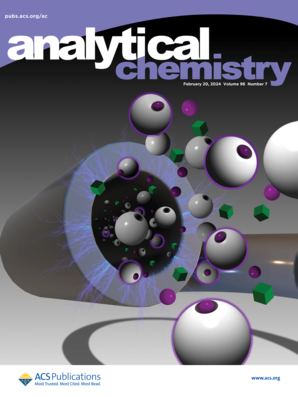Magnetic Field-Accelerated Nonthermal Plasma Digestion for Field Pretreatment and Determination of Heavy Metals in Biological Samples
IF 6.7
1区 化学
Q1 CHEMISTRY, ANALYTICAL
引用次数: 0
Abstract
Field analysis of heavy metals in biological samples is essential for assessing their potential threats to human health. The development of portable pretreatment and detection devices is crucial to address this challenge. Herein, a magnetic field-accelerated nonthermal plasma digestion device using dielectric barrier discharge (DBD) is designed for the rapid and environmentally friendly pretreatment of biological samples and subsequently combined with point discharge-optical emission spectrometry (PD-OES) for sensitive determination of heavy metals. With the assistance of a magnetic field, the DBD plasma digestion of a batch of six samples using a H2O + H2O2 + HNO3 system can be completed within 25–40 min, achieving the digestion efficiencies of 92–99%. The application of magnetic field enhances the electron density, excitation temperature, discharge current, and power of the DBD plasma, thereby reducing the digestion time by 40–69%. The determination of heavy metals in the digestion solution is directly performed using a miniature injection-detector based on hydride generation-PD-OES. Under the optimized conditions, the detection limits for Pb, Sb, Sn, and Bi are 2.4–8.2 μg L–1 (0.048–0.16 mg kg–1), with precisions of <5%. The accuracy and practicability of the present device are verified by measuring several certified reference materials, including GBW10023 (laver) and GBW10044 (rice), and real rice, laver, fish, milk, and blood samples. With its advantages of environmental sustainability, short digestion time, compact size, and lightweight design, the present device provides a simple and efficient tool for field analysis of toxic elements in biological samples.

求助全文
约1分钟内获得全文
求助全文
来源期刊

Analytical Chemistry
化学-分析化学
CiteScore
12.10
自引率
12.20%
发文量
1949
审稿时长
1.4 months
期刊介绍:
Analytical Chemistry, a peer-reviewed research journal, focuses on disseminating new and original knowledge across all branches of analytical chemistry. Fundamental articles may explore general principles of chemical measurement science and need not directly address existing or potential analytical methodology. They can be entirely theoretical or report experimental results. Contributions may cover various phases of analytical operations, including sampling, bioanalysis, electrochemistry, mass spectrometry, microscale and nanoscale systems, environmental analysis, separations, spectroscopy, chemical reactions and selectivity, instrumentation, imaging, surface analysis, and data processing. Papers discussing known analytical methods should present a significant, original application of the method, a notable improvement, or results on an important analyte.
 求助内容:
求助内容: 应助结果提醒方式:
应助结果提醒方式:


